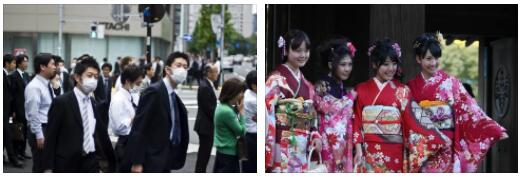Population. According to the 1936 census, Japan proper counted 69,254,148 residents, with an increase of almost 5 million individuals in recent years. The total population of the empire was 97,697,655. with an increase of more than 7 million individuals, largely attributable to Japan proper and Korea. Among the cities that have seen an increase in recent years, Ōsaka and Tōkyō should be noted above all, but in reality it is observed that the population is increasing in all regions. From the point of view of the distribution of the population, the development of the phenomenon of urbanism can be observed: centers with less than 5000 residents they mark a decline, more sensitive for less inhabited centers, while those with more than 5,000 residents are on the rise.
Of agricultural products (p. 20) a significant increase is observed for potatoes and cereals, while it is barely noticeable for rice.
The production of gold has almost doubled and that of silver is on the rise. A very strong increase also occurred for lead, tin, bismuth, mercury, zinc, and chromium and manganese ores, while for iron, phosphorus, oil production increased less evidently. ; the production of hard coal has decreased considerably.
In the field of communications (p. 26), the railway network has been significantly expanded (15,624 km. Of state lines in 1932-1933, as well as 1098 km. Under construction and 7242 km. Of private lines with another 3745 km. Under construction.). For civil aviation, see under.
Trade. – The Japanese trade balance, from the opening of the country to foreign trade (1868) to today, has almost always marked a surplus of imports over exports. This surplus, as shown in the table below, has however undergone variations strictly connected with the economic and political evolution of the country. In some period it even canceled itself, thus allowing the balance sheet to close with slightly surplus balances. In the five-year period 1884-88, for example, the establishment of the first cotton mills and the affirmation of some of the products of the Japanese industry (matches, lacquers, coal, copper, etc.) on neighboring markets, allowed an export surplus., excess that disappears in the following five years, thus restoring the normal physiognomy, especially due to the war with China (1895). A period of exceptional prosperity, marked by a dizzying rise in exports, was that of the World War, during which Japan easily replaced its allies in the Asian markets, too busy on the European battlefields to be interested in the trade of ‘ Far East. But, once the war ended, the resumption of European competition marked the return to normality and threw the Japanese industry into serious embarrassment, which in the meantime had created a colossal equipment, suitable for a superproduction regime; the crisis of 1929 made matters worse and had disastrous effects on the balance sheets. However, thanks above all to the particular conditions of the Japanese industry (low wages paid to a hand of very abundant work, very thorough rationalization of the entire industrial structure, subsidies and government control, etc.), which allows the production of copies of cheap goods, the conditions of trade have been improving and in recent years Japan has been able to invade world markets and even push for dumping in some of them (eg Yugoslavia in 1935). But the customs barriers erected to protect the European states, the United States and others and the abolition of the freedom of trade have placed the Japanese industry in a critical situation, also due to the fact that the country’s poverty in raw materials, necessary to feed their industries, forces them to be imported from abroad, while the processed products, due to the protective measures opposed by the various states, they find it more and more difficult to find an outlet. To the disastrous effects of the unfavorable relationship between the need for raw materials and the possibility of supply, in recent years Japan has sought a remedy both with the creation of new markets (Egypt, Palestine, Turkey, etc.), and with the intensification of maritime traffic. The recent contraction of the South American markets, due to economic circumstances and not to anti-Japanese sentiments, has also set Japan towards a compensated trading regime.
Industry has also benefited from the recent establishment of guilds (d ō gy ō -kumiai), species of industrial corporations, whose number, at the end of 1933, was over a hundred. Each guild, made up of all those who exercise the same branch of industry and who therefore have interests in common, controls their production, their purchases of raw materials or semi-finished products, sets prices and in some cases forms cooperatives. for the purchase of raw materials, the rental of machines, the sale of products, technical-commercial consultancy, etc. Guilds enjoy special privileges, such as income and business tax exemptions, and are subsidized by the government. In 1933, over one hundred of these corporations received about 1.5 million yen in government subsidies and about 4.5 million yen in low-interest loans over the past three years.
